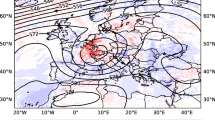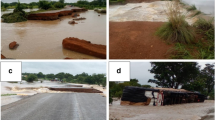Abstract
The hydrologists need effective procedures to assist them in predicting the implications related to high rainfall risks, both at gauged and ungauged areas. The first step for any assessment is estimating the rainfall values associated with various return periods in years. This information is obtained using rainfall frequency analysis techniques based on observed maximum daily rainfall values. The existence of a regional distribution for the rainfall frequency within a certain region is considered as a precious information for the hydrologists to estimate—with confidence—the expected rainfall at high return periods. The aim of this research is to determine the regional statistical distribution for various regions in Saudi Arabia. Saudi Arabia was selected to represent arid regions as it covers a large area of the Arabian Peninsula in addition to the availability of rainfall data compared with other similar countries. The data of 394 rainfall gauging stations were included in the study, which covers all Saudi Arabia in its 13 main regions. The data was analyzed using multiple frequency analysis methods and was subjected to various statistical tests including Akaike Information Criterion (AIC), Bayesian Information Criterion (BIC), Anderson-Darling Criterion (AD), Station-Year Analysis, and Index Flood Method, in order to determine the best regional statistical distribution and define the homogenous regions using regional analysis. The study concluded that the Log-Pearson type III distribution was the best model to describe the distribution of the daily maximum rainfall in the region. Saudi Arabia was sub-divided into seven homogeneous regions. Contour maps for the 2-, 5-, 10-, 25-, 50-, and 100-year rainfall were produced to predict the rainfall at any point within the Kingdom of Saudi Arabia.












Similar content being viewed by others
Change history
10 July 2020
The original version of this paper was published with error. Tables 1, 2 and 3 were incorrectly process and the corresponding author should be ���Ayman G. Awadallah���.
References
Abdulrazzak MJ, Sorman AU, Onder H, Al-Sari AM (1995) Flood estimation and impact: southwestern region of Saudi Arabia, Final report AR-10-51. KACST, Riyadh, Saudi Arabia in Arabic
Abdulrazzak M, Elfeki AM, Kamis A, Kassab M, Alamri NS (2019) Flash flood risk assessment in urban arid environment: case study of Taibah and Islamic universities’ campuses, Medina, Kingdom of Saudi Arabia, Geomatics. Natural Hazards and Risk 10(1):780–796
Akaike H (1973) Information Theory and Extension of the Maximum Likelihood Principle In: Csaki F, Petrov B N Eds. 2nd International Symposium on Information Theory, Akadémiai Kiado, Budapest, pp. 267-281
Al-Ahmadi KK, Al-Ahmadi S (2014) Rainfall-altitude relationship in Saudi Arabia. Advances in meteorology. Article ID 363029, 14 pages
Anderson TW, Darling DA (1954) A test for goddness of fit. Journal of the American Statistical Association 49:765–769
Awadallah AG (2015) Regional intensity-duration-frequency curves for Jeddah region, Saudi Arabia, using ordinary and L-moments approaches
Ball J, Babister M, Nathan R, Weeks W, Weinmann E, Retallick M, Testoni I Eds (2016) Australian rainfall and runoff: a guide to flood estimation, Commonwealth of Australia.
Buishand TA (1991) Extreme rainfall estimation by combining data from several sites, pp. 345-365
Chow VT (1964) Handbook of applied hydrology. McGraw-Hill, New York
Craig CC (1936) A new exposition and chart for the Pearson system of frequency curves. Annals of Mathematical Statistics 7:16–28
Cunnane C (1988) Methods and merits of regional flood frequency analysis. Journal of Hydrology 100(1-3):269–290
Cunnane C (1989) Statistical Distributions for Flood Frequency Analysis. Word Meteorological Organization Operational Hydrology Report, No. 33, Geneva
Dalrymple T (1960) Flood Frequency Analysis. US Geological Survey. Water Supply Paper, 1543 A
Dubai Municipality (2010) Sewerage, Drainage & Irrigation Master Plan - Technical Note on Rainfall Analysis
Dudani SA (1976) The distance-weighted k-nearest neighbor rule. IEEE Transactions on Systems, Man, and Cybernetics 6:325–327
Ewea HA, Elfeki AM, Al-Amri NS (2017) Development of intensity–duration–frequency curves for the Kingdom of Saudi Arabia, Geomatics. Natural Hazards and Risk 8(2):570–584
Ewea HA, Elfeki AM, Bahrawi NS, Al-Amri NS (2018) Modeling of IDF curves for stormwater design in Makkah Al Mukarramah region, The Kingdom of Saudi Arabia. Open Geosciences 10(1):954–969
Griffis VW, Stedinger JR (2007) Evolution of Flood Frequency Analysis with Bulletin 17. J. Hydrol. Eng. 12(3):283–297
Haddad K, Rahman A (2011) Selection of the best fit frequency distribution and parameter estimation procedure: a case study for Tasmania in Australia. Stochastic Environmental Research and Risk Assessment 25(3):415–428
Helsel DR, Hirsch RM (1992) Statistical Methods in Water Resources, U.S. Geological Survey, Water Resources Division, Reston, Verginia 22092, USA.
Hosking JRM (1990) L-Moments: analysis and estimation of distributions using linear combinations of order statistics. J R Stat Soc Ser B 52:105–124
Hosking JRM, Wallis JR (1997) Regional Frequency Analysis: Approach Based on L-Moments. Cambridge University Press, Cambridge
Johnson NL, Kotz S, Balakrishnan N (1994) Continuous univariate distributions, Volume 1. John Wiley & Sons, Inc., New York
Kite GW (1977) Frequency and risk analyses in hydrology. Water Resources Publications, Fort Colling
Kolmogorov A (1933) Sulla determinazione empirica di una legge di distribuzione. Instituto Italiano Degli Attuari Gioroni
Laio F, Di Baldassarre G, Montanari A (2009) Model selection techniques for the frequency analysis of hydrological extremes. Water Resour. Res. 45(7)
Mielke PW, Johnson ES (1974) Some generalized beta distributions of the second kind having desirable application features in hydrology and meteorology. Water Resour. Res. 10(2):223–226
Ministry of Communications (1998) Highway design manual – design of roadway, Kingdom of Saudi Arabia
Ministry of Housing, Utilities and Urban Development (2008) Egyptian code of practice for urban and rural road works, Code 104, Volume 7, Cairo
Nguyen VTV, Tao D, Bourque A (2002) On selection of probability distributions for representing annual extreme rainfall series, Ninth International Conference on Urban Drainage (9ICUD). ASCE Library, Portland, Oregon, United States
Ouarda TBMJ, Charron C, Chebana F (2016) Review of criteria for the selection of probability distributions for wind speed data and introduction of the moment and L-moment ratio diagram methods, with a case study. Energy Conversion and Management 124:247–265
Papalexiou SM, Koutsoyiannis D (2013) Battle of extreme value distributions: a global survey on extreme daily rainfall. Water Resources Research 49(1):187–201
Pilgrim DH, Chapman TG, Doran DG (1988) Problems of rainfall-runoff modelling in arid and semiarid regions. Hydrological Sciences Journal 33(4):379–400
Rao AR, Hamed KH (2000) Flood frequency analysis. CRC Press, Boca Raton
Riyadh Municipality (2010) Engineering guidelines and standards for flood protection in Riyadh City - design guide for flood drainage networks. (in Arabic)
Salinas JL, Castellarin A, Viglione A, Kohnova S, Kjeldsen TR (2014a) Regional parent flood frequency distributions in Europe - Part 1: Is the GEV model suitable as a parent European distribution? Hydrology and Earth System Sciences 18(11):4381–4389
Salinas JL, Castellarin A, Kohnova S, Kjeldsen TR (2014b) Regional parent flood frequency distributions in Europe - Part 2: Climate and scale controls. Hydrology and Earth System Sciences 18(11):4391–4401
Schwarz G (1978) Estimating the dimension of a model. The Annals of Statistics 6(2):461–464
Smirnov NV (1948) Table for estimating the goodness of fit of empirical distributions. Annals of Mathematical Statistics
Stedinger JR, Vogel RM, Foufoula-Georgiou E (1993) Frequency analysis of extreme events, chapter 18. In: Maidment DA (ed) Handbook of Hydrology. McGraw-Hill, New York
Subyani AM (1999) Topographic and seasonal influences on precipitation variability in southwest Saudi Arabia. Journal of King Abdulaziz University 11:89–102
Vogel RM, Fennessey NM (1993) L moment diagrams should replace product moment diagrams. Water Resources Research 29(6):1745–1752
Wilks DS (1993) Comparison of three-parameter probability distributions for representing annual extreme and partial duration precipitation series. Water Resour. Res. 29(10):3543–3549
Wiltshire SE (1986a) Regional flood frequency analysis I: Homogeneity statistics. Hydrological Sciences Journal 31(3):321–331
Wiltshire SE (1986b) Identification of homogeneous regions for flood frequency analysis. Journal of Hydraulics 84:287–307
WMO (2009a) Guide to hydrological practices, volume II: Management of water resources and application of hydrological practices, 6th edition, WMO-No. 168. World Meteorological Organization, Geneva, Switzerland
WMO (2009b) Guidelines on analysis of extremes in a changing climate in support of informed decisions for adaptation, WMO-TD No. 1500. World Meteorological Organization, Geneva, Switzerland
Zaman MA, Rahman A, Haddad K (2012) Regional flood frequency analysis in arid regions: a case study for Australia. Journal of Hydrology 475:74–83
Author information
Authors and Affiliations
Corresponding author
Additional information
Responsible Editor: Broder J. Merkel
The original version of this article was revised: The original version of this paper was published with error. Tables 1, 2 and 3 were incorrectly process and the corresponding author should be “Ayman G. Awadallah”. Given in this article is the corrected correspondence and tables.
Rights and permissions
About this article
Cite this article
Abdeen, W.M., Awadallah, A.G. & Hassan, N.A. Investigating regional distribution for maximum daily rainfall in arid regions: case study in Saudi Arabia. Arab J Geosci 13, 501 (2020). https://doi.org/10.1007/s12517-020-05413-8
Received:
Accepted:
Published:
DOI: https://doi.org/10.1007/s12517-020-05413-8




